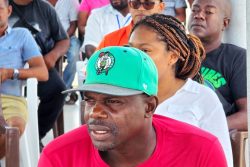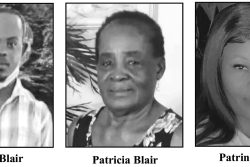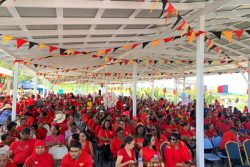There have been a number of criticisms about the recently launched ‘Atlantic Readers’ by the Ministry of Education. These are literacy texts for use in primary schools starting at age six that provide local settings for the stories presented to which it is thought children could relate. The literacy aspects of the texts are impressive, and clearly a great deal of work and thought has gone into creating the necessary levels of difficulty for each stage of child development. The problem for the authors and editors is that this exercise does not exist in the abstract, however competent their approach in the technical department might be. It is the social envelope within which the literacy core has to be delivered that will cause them all the difficulties, and it is indeed this aspect on which the critics have homed in.
The reason for that is quite simply this is a complicated society, not a homogeneous one. The children for whom these books are intended come from a variety of backgrounds, ethnicities and religions, and what might be typical for one group may be quite untypical for another. In particular there is the minefield of social mores which are not uniform across the different communities. At the launch of the series Assistant Education Officer Samantha Williams was reported as saying that local writers were entrusted with producing something which would meet the “cultural complexities” of Guyana and take into consideration the “demographic uniqueness” of all the nation’s children. Letter-writers to this newspaper are not persuaded that this has been achieved.
Most, although not all of the criticisms which have emerged to date have been based on the first of the Atlantic Readers, i.e. Book I. This is perhaps to cause a distortion in perceptions, since some elements of the disapproval might arguably have been mitigated had a longer view been taken to include later books. In addition, while the Atlantic Readers incorporate elements of health and family life education, they are not social studies works as such, and are therefore restricted in terms of the variety of scenarios and information they can convey. Their ultimate purpose is, as was repeatedly made clear, a literacy one.
Certainly at the Book I stage, which caters for six to seven-year-olds, the vocabulary will have to be limited, the personae in the stories limited and the activities in which they participate limited as well. The convention for beginners where reading is concerned is to start with a single family, but in Guyana’s demographic circumstances the authors would have been faced with a decision about which one. They opted for a mixed family with an African father and an Indian mother, although neither of the children has been given an Indian name. However, their demographic selection in this instance one would have thought eminently defensible.
They do land themselves with an anomaly, however, since after introducing “Mommy” and “Daddy”, they move to “Grandmother” and “Grandfather”, forms of address not used by anyone in this country. Perhaps they were trying to evade the problem of which grandparents these were, so they didn’t have to make a choice between ‘granny and grandad’ or ‘aja and ajee’/‘nani and ‘nana’. That nevertheless might be too indulgent an interpretation, since “Mother” and “Granny” turn up in Book 2.
What one can say about the first three books is that no fleeting glance of a Chinese makes their appearance, or, for that matter, anyone Indigenous. At least if only pictorially, the other ethnic inhabitants of this nation should be shown. It may be that in Books 4-6, which this newspaper has not seen, Indigenous ways of life at least come in for coverage at some level, but that is another matter. As it is critics have complained about the deracination, in a literal sense, of those figures who are represented, and it is an objection not without merit.
A surprising number of the children depicted in the accompanying drawings appear to the reader to be European of some kind, or in other cases lacking any racial identity. The artist would certainly be justified in including the occasional Portuguese in a group of children, and there would be good reason for adding a number who were of mixed ethnicity, but not those who will be identified as not emanating from this land at all. Now it may be that this is not what was intended in the illustrations, but if so, then they should be looked at again.
In fact it is the iconography of the books which has attracted the most attention, and it is certainly the pictures which will first lodge themselves in the minds of the children. Even more than the text, therefore, great care has to be taken about the images shown. From the toothless market vendor – an unnecessary and inaccurate stereotype – to the extraordinary photo of bananas, apples and strawberries (of all things), or market purchases including carrots, broccoli and Mexican chili peppers, the imagery fell lamentably short of the objectives the Ministry was promoting. The thing about our cuisine is that all groups will eat or at least recognise everything, and while in Book 2 there were pictures of roti and curry and shrimp curry, nothing much was said about them. No chowmein either, or cook-up rice, and just forget about cassava bread.
Then in Book 2 there was the picture of fireworks over Tower Bridge in London, supposedly to illustrate the topic of fireworks at Diwali at which time it might be noted, they are unquestionably an aberration, just as they are at Christmas. If the writers thought it necessary to introduce the concept of fireworks, that should have been at New Year, with an accompanying photo of the GDF display on the seawall at midnight.
What concerned everyone was the dietary information conveyed in print as well as visually. One healthy meal given to the father comprised fish, carrots and broccoli. There was even a reference to cranberry juice for granny. No one would think this country produced a wide variety of nutritious vegetables and far more fruits than the north temperate zone is home to. And yet there was the family travelling to Lethem by plane – the person who wrote this section had clearly never been there – and all that seemed to happen was that they had a meal of stew. They might as well have gone round the corner to the Parade Ground and saved themselves the trouble of a plane trip. The thing about Lethem and that part of the Rupununi is that it is full of any number of mango trees, yet not a mango made it past the apples in Books 1-3. It might be added that it is not clouds which catch the attention on a clear day on the plane trip, but the forest below, and once in Lethem and surrounding areas the Kanuku mountains can be discerned in the distance. For coastal children, is there no argument for introducing them to the concepts of a forest and mountains?
One section clearly in need of excision although not alighted on by the critics, is the part about pets (‘Caring our pets’, not even Caring for our pets) in Book 2, and earlier references in Book I. No kindness to animals here. The dog, a beautiful Labrador, clearly off the internet (no Guyana yard dog in the Atlantic series), is admonished by the child for coming in the house, jumping on the bed and various other serious sins. What it did right was clap its paws and dance on the mat, which earned it a “Good Girl”. Any dog which claps its paws qualifies for an immediate citation in the Guinness Book of Records, while a dancing dog would be a hit on social media. As for the ‘care’ in the next book, among other things children are told “Bones are his best food”. Well, no. Bones are good for the teeth, but any dog fed on mostly bones will soon suffer from malnutrition. The concept of ‘pet’ has not yet lodged itself in the authors’ minds.
The matter of Indigenous children who live in the interior is problematic. Minister Manickchand was reported as indicating that the Readers would be translated into Wapichan and other Indigenous languages spoken locally. (One wonders what the Wapichan for broccoli is.) For hinterland children who may have to travel long distances to school some of whom will have to use canoes or a speedboat, and may have to spend some of their time helping their parents in the cassava fields or learning how to make the various products from cassava, the Atlantic Readers will seem alien indeed. It is not enough to translate them into Indigenous languages, there should be special editions for the various interior nations reflecting their own lifestyle, at least at the earliest stages of the literacy learning process.
Contrary to what some critics have suggested, there is probably no case for scrapping an entire print run at this stage; free school texts have a short shelf life, and more will soon be needed. In addition, in terms of its specific literacy aims the Readers might well be successful. However, it would be advisable for the Ministry to consider revising the second edition. While there are things which need amending, the educational authorities have in principle the right approach in the sense that they want something which is relevant to our context.
They are, of course, operating in a very sensitive area, and it is unlikely that the literacy experts who worked on this edition will necessarily see all the pitfalls in the social arena which will become a source of controversy. They should therefore be open to inviting outsiders from the different groups to review various sections, and listen to their suggestions with a view to incorporating as many of them as is possible within a given framework. Most of all they have to start by placing themselves in a neutral position, so all groups and religions are presented equally, something which they did not always succeed in doing, although space did not allow for examples to be provided here.
As an attempt to come to terms with our “complexities” the Atlantic Readers are not an unmitigated success, but they are not an unmitigated failure either, and certainly not in relation to literacy per se. As such the Ministry should be amenable to seeing their efforts as a work in progress.









